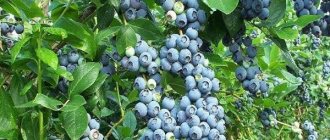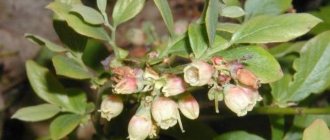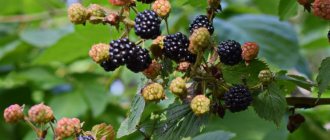Do blueberries grow in Siberia?
Blueberries are grown in summer cottages in all regions of Russia.
Gardeners fell in love with it for its unpretentiousness in growing and the beneficial properties of the berries. Thanks to many years of selection work, the shrub can be grown even in the harsh climate of the Siberian region. In order for a garden blueberry bush to grow and develop well, it is necessary to choose the right variety, which must be resistant to frost and also have immunity to diseases. Did you know? In America, blueberries have long been called “starberries” because of the shape of their flowers, which resemble a star.
List of varieties adapted to harsh weather conditions:
- Blue placer is a medium-sized bush, reaching a meter in height. The leaf blades are not large, light green in color, with a matte surface. The fruits weigh 0.6 g and have a spherical shape. The skin is elastic, blue with a bluish coating. The pulp has a sweet taste. From one bush you can harvest up to 1 kg.
- Taiga beauty. Bush, 90 cm, with a spreading, highly branched crown. The berries are dark blue in color, with a noticeable bluish tint. The fruits have a sour taste. The plant can withstand temperatures as low as -43°C.
- The Shegar variety has a spreading crown and reaches a height of 1 m. The berry harvest from a bush can be up to 1.5 kg. Winter hardiness is high, up to -35°C.
Blueberries for Siberia: the best varieties
Blueberry appearance
The main advantage of blueberry varieties for Siberia is frost resistance. But at the same time, breeders were able to combine this quality with high yield.
Description of the best blueberry varieties:
- “Northern Country” is a blueberry variety that can easily withstand forty-degree frosts. Despite the fact that the bushes of this variety are low and not voluminous, the yield is up to 8 kg. The berries are not large, but very sweet, so they are ideal for making blueberry jam or preserves;
- “Shegarsky” is a late-ripening variety with excellent yield, up to one and a half kilograms per bush. A distinctive feature is the simultaneous ripening of berries, so harvesting is convenient;
- “Blue Placer” is also a late-ripening variety, but has a record yield of 2 kg per bush. This is a compact shrub up to 1 meter high; a maximum of 5 berries grow on one cluster;
- “Yurkovsky” - this variety has high frost resistance, but an average yield of approximately 1 kg of berries per bush. At the same time, the berries are very large and fleshy. This became possible due to the characteristics of the bush: it grows up to one and a half meters in height and has a sparse crown;
- “Taiga Beauty” is a mid-season blueberry variety. A distinctive feature is the pronounced sour taste of the pulp. The shrub is tall with a spreading crown, so the berries grow large.
Interesting. Blueberry varieties for the Urals will be the same, since both climatic zones have a harsh climate.
Garden blueberries - description of the variety
Externally, blueberries resemble blueberries, but these crops have many differences. Blueberries are small shrubs with small leaves, while garden blueberries can reach a meter in height, and tall varieties can grow up to two meters or more.
Figure 1. External features of garden blueberries
Blueberry branches are covered with dark brown or gray bark, on which there are fairly large leaves (about 3 cm in length). During the flowering period, the bush is covered with small white or pink flowers.
But the main difference between blueberries and blueberries concerns the berries. The flesh of blueberries has a rich blue color, while blueberries have a greenish tint. In addition, blueberries are much larger and have a slightly oblong shape (Figure 1).
It is noteworthy that in terms of soil requirements, it is much easier to grow blueberries at home, which can successfully bear fruit in any soil, while blueberries prefer soil from pine forests.
Blueberries for Siberia: the best varieties
Growing berry bushes in a personal plot is a favorite activity of gardeners and vegetable gardeners.
Each of them dreams of growing not the usual strawberries or currants at their dacha, but trying something more interesting and exotic. When talking about blueberries, people mostly imagine the taiga with its swampy soils, on which small branched bushes grow with round or oblong blue berries. Varietal plants are most often tall and spreading. Blueberries are valued, first of all, for their excellent taste and large amount of useful vitamins and microelements. The climate of Siberia is not the most optimal for growing blueberries, as it is a heat-loving crop. Breeders have created high-yielding and frost-resistant blueberry varieties that are ideal for garden plots in Siberia.
Pests and diseases
In Siberia, the most dangerous diseases for blueberries are fungal diseases of the root system or stem. They infect bushes when the soil is over-moistened, as well as when pest infections spread.
In summer, leaflets may appear on the leaf blades and can be detected by leaf curling and selective wilting. To get rid of leaflets, foliar treatment is carried out with a solution of tobacco or laundry soap. Timely preventive measures help prevent the development of fungus and the appearance of parasites:
- regular loosening of the soil to destroy weeds;
- autumn whitewashing of the trunk to repel insects and rodents in winter;
- removal and burning of fallen leaves;
- timely change of mulch;
- control over irrigation.
Planting blueberries in the ground
It is best to plant blueberry seedlings in open ground in the spring, which will allow the plant to go through a period of adaptation and gain nutrients for the autumn-winter period. The optimal time for the procedure is from mid-April to mid-May.
Planting material is purchased from a local nursery. Seedlings chosen are 2-3 years old, with a closed root system. Before purchasing, you need to carefully inspect the plant for diaper rash, rot and other defects. If they are present, then it is better to refuse the purchase.
Selecting a location
Blueberries should be planted in well-lit areas; it is advisable to choose an area where other types of shrubs have not previously been cultivated. The area must be protected from drafts - pests and fungal spores can travel long distances with the wind.
Important! The soil for planting should have good moisture permeability and its pH should be slightly acidic or acidic. Blueberries will develop slowly in soil with neutral acidity.
You should not plant plants in lowlands where there is a risk of flooding - this will lead to rotting of the root collar and death of the bush. It is best to plant the crop along a fence or wall of a house on the south side.
Soil preparation
The area for planting is prepared in advance, about six months before the procedure. The selected area is cleared of debris and weeds. The soil is loosened to a depth of 30 cm. If the pH of the soil is neutral, then it is necessary to increase its acidity, which is achieved by irrigating the area per 1 m² with a solution of 9% apple cider vinegar (100 g per 10 liters of water). To acidify the soil, you can use sulfur, 70 g per 1 m², which is added during digging to a depth of 30–40 cm.
At what distance are blueberries planted?
For better pollination, several varieties of blueberries are grown on the site. They should be located close to each other - this will improve the fruitfulness of the crop. Planting of shrubs is carried out with an interval of 1 m between plants. The rows are made at a distance of 1.2 m from each other.
Important! When planting, the root collar must be deepened 5 cm into the ground - this will protect the plant from freezing during frosts.
Planting depth
The seedlings must be up to 30 cm in height and have a root system of at least 20 cm. Therefore, the hole for planting is made shallow - up to 40 cm. The width of the hole should be about 50 cm.
How to fertilize a hole
The planting hole must be prepared 2 weeks before the planting procedure.
The hole is filled to the middle with a substrate consisting of:
- topsoil - 5 kg;
- peat - 5 kg;
- pine needles - 500 g;
- sawdust - 500 g;
- sand - 5 kg;
- sulfur - 50 g.
After 2 weeks, the soil in the pit is loosened. The seedling is lowered into the hole, carefully straightening the roots along the mound of substrate. Next, add ordinary soil to the top of the hole and water the plant with 5 liters of water. The soil around the trunk is mulched with peat.
Planting and care
Soil preparation
To plant blueberries, first of all, choose a suitable sunny place , reliably protected from the wind. Pay special attention to lighting: if the bush is planted in the shade, your harvest will be small, tasteless and few in number. Conduct a soil examination to find out its acidity level - blueberries grow only in acidic soil. The ideal acidity indicator is pH 3.5-4.5. Also, the area where you are going to grow blueberries must be absolutely fresh, never cultivated before. At the very least, the land should lie fallow for several years before planting.
Time of year to plant
plant blueberries in the ground in spring and autumn , but a seedling planted in the spring has time to get stronger over the summer, so it will be easier for it to survive the winter.
Spring planting
It is necessary to plant blueberries in the ground before the buds have time to swell. When choosing a seedling, give preference to those sold in pots or containers. Before planting, lower the pot into a deep container with water for half an hour, remove the seedling and very delicately try to straighten the roots and clean them of store-bought soil.
To plant seedlings, dig holes half a meter deep in a suitable area at a distance of half a meter from each other (for low-growing varieties), or a meter (for tall varieties). Loosen the bottom of the holes and create acidic conditions in them so that blueberries can develop comfortably in the ground. To do this, place peat mixed with pine needles and sawdust on the bottom and add 50 grams. sulfur, thoroughly mix and compact the entire substrate. Now place the seedling in the hole, carefully straighten its roots and cover it with soil, water it and cover it with a mixture of pine sawdust and peat.
After planting, the seedlings are watered every 2 weeks, enriching every 5 liters of water with 20 grams. citric acid or apple cider vinegar.
Autumn landing
Autumn planting completely repeats all the steps from the previous paragraph. But after planting a one-year-old seedling, it is necessary to remove all weak and weak branches using pruners, and all strong branches must be shortened by half. Please note that two-year-old seedlings are not pruned.
Planting blueberry seedlings in the ground
Growing blueberries in a country house or garden plot is a simple process. In order for the bushes to develop normally and bear a lot of berries, you need to know all the intricacies of growing crops in your garden or vegetable garden.
Read more about planting and caring for blueberries.
Planting depth
Blueberries are buried 3–4 cm from the root. Initially, you should dig a hole of a suitable size. According to the standard, holes are made of the same width and depth. The optimal size is 40-60 cm. Most often, medium-sized holes are dug - 50x50 cm. However, some gardeners advise making large holes, the size of which is 80-90 cm, since the roots of the plant grow well in width. The variety of the crop is of great importance.
The planting depth is directly related to the soil:
- Heavy loam. In this case, the holes should be wide, but not too deep. It is optimal to make them in the following sizes: 70–80×20 cm. If the holes are too deep, water will stagnate in them. As a result, the root system of the plant will begin to rot.
- Light loam. Optimal pit dimensions: width 60 cm and depth 40 cm.
- Heavy clay soil. It is recommended to plant in ridges. To do this, dig a shallow hole (10 cm), lay out a mixture of sand, peat and sawdust so as to form a low mound. The seedling is installed in the center so that it is at ground level. Next, the sprout must be mulched with a 10–15 cm layer of sawdust.
- Sandy or peat soil. Pits are made with a diameter of 1 m and 50 cm deep. A special mixture of high-moor peat, sand, sawdust and pine needles is laid out in the hole. The seedlings are planted in such holes.
In order for blueberries to grow in comfort, it is necessary to make a fence. Trenches are made from any strong material around the planting holes. Plastic, bricks, stones, wood are suitable for this. You can lay geotextiles at the bottom of the hole. Thus, the plant bush will be isolated from contact with ordinary soil, and the rest of the soil in the garden will not oxidize. A 200 liter barrel will be very useful. It must be divided into two parts. A drainage layer (coniferous tree bark) is laid on the bottom of both halves, and then a special acidic substrate is added.
How to fill a hole
When the planting hole is dug, it must be filled with a soil mixture of the required acidity level (pH 3.5–4.5). The substrate for planting blueberries is prepared from high-moor peat (40–60%), pine litter (rotted pine needles, 20–40%) and yellow sand (10–20%).
The soil mixture can be supplemented with a small amount of sulfur or products containing it. For example, this is ammonium sulfate - a mineral fertilizer that is an excellent oxidizing agent: 50 g will be enough.
To ensure that the work is not done in vain, it is necessary to measure the acidity level of the prepared mixture. To do this, you can use a special device (pH meter) or other means (litmus papers). If you don’t want to prepare a special substrate, you can purchase a suitable mixture in the store.
It is forbidden to use any organic fertilizers for mulching, as they alkalize the soil, and this negatively affects blueberries. Sawdust from coniferous trees is best suited for mulch - it must be rotted. Fresh sawdust should not be taken, as it deprives the soil of nitrogen.
Also find out what to do if blueberries do not bear fruit.
After preparing the substrate, you can proceed directly to planting:
- Add half of the soil mixture to the dug hole.
- A mound is made in the center of the hole on which the seedling is placed. Therefore, only plants with an open root system should be planted. Seedlings from containers are planted on a horizontal surface, not on a hill.
- The roots of the plant need to be straightened (again, if the root system is open).
- After this, the pit is filled with the remaining amount of substrate. It should be lightly compacted.
- The seedling needs to be watered abundantly: water once, let the liquid be completely absorbed, water a second time.
- If the soil has settled after watering, add more soil on top.
- Finally, all that remains is to mulch the plant. In addition to rotted sawdust from coniferous trees, other components can be used. Suitable acidic peat, tree bark, pine needles (also rotted). The components are combined in equal proportions with sand or hay, after which the ground around the seedlings is mulched with a layer of 3–5 cm.
Planting, care and cultivation of various varieties of garden blueberries, reviews
Dark blue, almost black, covered with a light whitish coating, juicy, sweet and sour blueberries are loved by many; they have many beneficial properties that affect the functioning of the internal organs of the whole body.
It is the fresh berry, which retains the largest amount of vitamins and important microelements, that is valued by nutritionists around the world. Blueberries protect the heart and blood vessels, regulate the functioning of the pancreas and intestines, significantly slow down the aging of nerve cells and, consequently, the cerebral cortex, restore vision, enhance the medicinal properties of medications, speed up metabolism and lower blood sugar levels .
In addition, berries can reduce the risk of radioactive radiation, are useful for hypertension, rheumatism, atherosclerosis, are rich in antioxidants, which reduces the risk of cancer, and can support and activate the vitality of even an elderly body. Not only berries, but also blueberry leaves are considered beneficial. Their decoction is recommended for heart disease.
It is not surprising that many today want to plant this miracle berry on their plots. Unfortunately, wild blueberries cannot be cultivated, but a huge variety of domestic varieties are available to gardeners, whose seedlings can be purchased in stores and planted on your own plot. Perhaps garden varieties of berries are not as rich in vitamins as their forest counterparts, but they produce a larger harvest , larger berries and are resistant to many types of diseases and pests. Of course, this does not mean that blueberries do not require care. Growing blueberries is not for the lazy; their bushes are finicky and require proper planting and careful, diligent supervision.
Varieties of early, mid-late and late ripening
Gardeners should remember that late-ripening shrubs are not suitable for regions with short summers and long winters. Thus, the climate of northern Russia, some regions of Siberia and the Far East, where night frosts on the soil can be observed as early as August, will not provide blueberries with all the conditions necessary for development. The harvest, if it has time to ripen, will only be in small quantities.
Table: early ripening blueberry varieties
| Variety | Bush | Fetus | Productivity |
| River | Tall, erect. | Sweet, 19 mm in diameter. | Up to 9 kg per bush. |
| Chippewa | Low-growing bush, up to 120 cm. spherical shape. | Sweet, 18–20 mm in diameter. | 7–9 kg per bush. |
| Collins | Bush height up to 180 cm. Not spreading. | Medium sized fruits. They are not stored for a long time. | Up to 3 kg per bush. |
| Sunrise | The bush is spreading. Height 120–180 cm. | Large fruits: 17–20 mm in diameter. Very tasty. | 3–4 kg per bush. |
Photo gallery: early blueberry varieties
Table: blueberry varieties of medium-late ripening
| Variety | Bush | Fetus | Productivity |
| Blugold | The height of the bush is up to 120 cm. It has many shoots. | The berries are sweet and sour, up to 18 mm in diameter. | From 5 to 7 kg per bush. |
| Thoreau | Tall, non-spreading bush. | The fruit is sour, up to 14 mm in diameter. | Up to 9 kg per bush. |
| Herbert | The height of the bush exceeds 2 m. | The fruits are sweet, large, 20–22 mm in diameter. Do not crack. | Up to 9 kg per bush. |
| Bluejay | Powerful tall bush. | The berries are large, up to 22 mm in diameter. | 4–6 kg per bush. |
| Elizabeth | The bush is tall and spreading. Can grow up to 2 m without support. | The fruits are large. The taste is sugar-honey. | Up to 6 kg per bush. Maturation is not simultaneous. |
Photo gallery: mid-late blueberry varieties
Table: late ripening blueberry varieties
| Variety | Bush | Fetus | Productivity |
| Darrow | The height of the bush is no more than 150 cm. Spreading and highly branched. | Berries up to 18 mm in diameter. Sweet. | From 5 to 7 kg. |
| Jersey | Tall bush up to 2 m. | The berries are medium in size, 16 mm in diameter. They have a pleasant taste. | From 4 to 6 kg. |
| Ivanhoe | Medium-sized bush, branches stretch upward. | Fruit size is below average. The taste is dessert. | From 5 to 7 kg. |
| Elliot | Tall bush with vertically growing branches. | The berries are large, dense, sweet. Fruiting lasts for three weeks. | Up to 6 kg per bush. |
| Bonus | Spreading bush, height up to 150 cm. | The fruits are large and sweet. They are stored for a long time. | Up to 5 kg per bush. |
| Chandler | The bush grows up to 170 cm. Powerful and spreading. | The berries are large, can reach 25–30 mm in diameter. | Up to 5 kg per bush. Fruit harvesting is not simultaneous. |
| Dixie | The bush is powerful and spreading. Height up to 2 m. | The berries are up to 22 mm in diameter. Prone to shedding. | From 4 to 7 kg. |
Varieties for cultivation in certain regions
Among the many varieties of blueberries, you can choose those that can successfully grow in specific regions. Climate, soil quality and other location features influence the choice of breeding product for your garden.
Important! Blueberries should not be fed with organic fertilizers. After all, they make the soil alkaline, and this crop prefers acidic soils.
In the middle zone
In the middle zone, where cold winters are not uncommon, the following have proven themselves best:
- Bluecrop.
- Patriot.
- Bonus, which is a variety whose fruits ripen at the end of August and provide a yield of about 6 kg. The plant can overwinter in frosts down to -29ºС.
- Blugold.
- Duke.
- Erliblue.
- Spartan.
- Northland.
- Darrow.
- Bluray, whose bushes rise to a height of 1.8 m, and the yield is 7 kg. These blueberries can withstand temperatures as low as -34ºC.
In Belarus
The most cultivated variety in Belarus is Bluecrop, which was already discussed above.
Also popular in this country:
- Patriot.
- Blueetta is an early, high-yielding bush that allows you to pick berries with aromatic pulp that are distinguished by a very good taste already at the very beginning of July. Productivity reaches 9 kg.
- Chanticleer, an early ripening variety that produces 2 harvests during the season. Large fruits up to 2.2 cm in diameter have a wine-fruity taste.
- Erliblue.
- Blue Brigitte, abundantly producing fruits 1.5 cm in diameter with good taste.
- Boniface grows above 2 m and produces large fruits with a spicy taste and attractive aroma.
- Hannah Choice, it is also distinguished by its tall growth and good bush productivity. The ripe fruits can stay on the branches for a long time without falling off.
- Pink Lemonade and Pink Champagne, they are new products and are distinguished by the pink color of the fruit. Their taste combines honey tones and lemon sourness. The variety is able to tolerate moderate frosts.
In the Nizhny Novgorod region
The most popular in this Volga region are:
- Rancocas, distinguished by berries with very good gastronomic qualities, high productivity (up to 7 kg from 1 bush), winter hardiness, good transportability and resistance to diseases and pests.
- River.
- Sunrise.
- Puru.
- Duke.
- Erliblue.
In outskirts of Moscow
The best harvests in this region are brought by tall varieties of early and medium ripening, yielding up to 10 kg per bush.
Important! Blueberries of any type gain sweetness in warm and sunny summers. Rainy and cool weather gives the fruits excessive astringency
List of the most popular:
- Duke.
- Nelson, which is a medium-sized bush (up to 1.6 m), on which fruits up to 2 cm in diameter ripen. These berries have a sweet taste and good keeping quality. The productivity of 1 bush reaches 9 kg.
- Bluecrop.
- Northland.
- Brigitte Blue is a late maturing hybrid. Tall bush - 2.2 m. Medium-sized fruits have high gastronomic qualities. The productivity of the bush reaches 6 kg.
- Rancocas.
For the Black Earth Region
In this region with fertile soil and moderate frosts, the most popular blueberry varieties are:
- Elliot, which is a tall (up to 2.1 m in height) late-ripening hybrid, producing up to 6 kg of berries from 1 bush. Small fruits have good taste.
- Darrow.
- Liberty.
- Elizabeth, characterized by large (up to 2.2 cm in diameter) fruits with a sweet, but not cloying, taste and delicate aroma. The variety can withstand frosts down to -35ºС.
- Bluejay, which, according to gardeners, has the most exquisite taste among other varieties. It has very large berries, reaching 4 cm in diameter. Up to 6 kg of berries are harvested from a Bluejay bush.
- Aino, producing up to 7 kg of medium-sized but sweet fruits from 1 bush. The crop can tolerate frosts down to -35ºС.
- Blue Sweet, the fruits of which begin to ripen at the end of June and form a good harvest of up to 6 kg per bush. The berries exhibit a sweet taste and fruit weight is about 4 g.
- Bluecrop.
- Patriot.
- Bonus.
- Jorma, capable of wintering in short-term frosts down to -39ºС. It has large berries with a sweet and sour taste and a pleasant aftertaste.
- Northland.
- Rancocas.
- River.
- Sunrise.
Blueberries are confidently conquering their niche in the gardens of various regions. This is facilitated not only by the obvious quality of this crop, but also by the abundance of its varieties, which are actively bred by breeders.
Site selection and preparation
Site illumination and groundwater
- To grow blueberries, choose a place well lit by sunlight, light shading is possible, but the berries will taste more sour.
- Avoid close proximity to groundwater - it should be at a depth of more than 1 meter.
- It is advisable that the site be protected from drafts and strong winds.
Soil composition
In order for blueberries to successfully take root and bear fruit, you will need soil that is acidic or slightly acidic. A mixture of peat and sand is ideal. Can be grown in clay soils, providing good drainage. The necessary “ingredients” are added to the planting hole.
Predecessors and preparation of land for planting
The plant does not like its predecessors. It’s good if the land is fallow for a couple of years before planting blueberries.
1 month before planting, start preparing the site: add organic matter (rotted manure, compost) and a complex of mineral fertilizers when digging. If planting is planned for spring, it is better to do this in the fall.
Propagation by green cuttings
To use propagation by green cuttings, you will need a pre-prepared area with mother bushes from which you can take harvesting material. The optimal time for the procedure will be mid-summer (late June - early July), and the most suitable shoots are young growth that has grown in the spring or one-year-old shoots left after pruning.
The choice of raw materials should be taken very seriously - the quality of future bushes will depend on this. The selected shoots should be strong and well developed, covered with healthy leaves. It is the leaf cover that will help replenish the stem’s strength before the rhizome appears, feeding it with moisture and minerals.
The cutting process occurs as follows:
- The shoots are cut to a height of about 6 cm, after which they are soaked in water or a fungicidal solution, which will act as a disinfectant.
- A special soil is prepared, consisting of acidic peat mixed with microfertilizers, which are intended for the long-term release of useful substances.
- The soil is poured into cassettes, carefully compacted and moistened. Cuttings are planted (to a depth of about 4–5 cm), and the containers with the cuttings themselves are placed in a room (for example, a greenhouse) under certain conditions.
Video: Green blueberry cuttings
Conditions for rooting cuttings:
- The floor covering on which the cassettes will be displayed must consist of drainage. As drainage, a mound of gravel, 10 cm thick, and a layer of sand, 5 cm thick, are most often used. On top, everything needs to be covered with any durable material (agro-fabric can be used);
- The air humidity in the greenhouse must be constantly maintained at 100%. This result can be easily achieved with the help of special foggers, the principle of which is to spray water throughout the room to the size of microdrops. In addition to the humidity level, such equipment also maintains the required temperature;
- The temperature should be at +20…+24°C. In case of persistent summer heat, it is recommended to use additional shading of the greenhouse with nets.
If all recommendations are followed, rooting of cuttings occurs in the fourth week after planting. After this, the seedlings gradually begin to adapt to normal greenhouse conditions, and then the containers with the plants are transferred to an area with open air.
Important! The entire process of preparation, rooting and adaptation of cuttings takes from 1.5 to 2 months
Pests and diseases of blueberries
Blueberry pests
Planting and caring for garden blueberries must be carried out in accordance with agrotechnical rules, and then your plants will be healthy and resistant to diseases, but sometimes healthy plants must be protected. Most often, blueberries suffer from birds that peck the ripening fruits.
In order to preserve the blueberry harvest, carefully stretch a net with small cells over the bushes. As for insects, they do not cause noticeable damage to blueberries, although they do not change from year to year, and sometimes in the spring blueberry bushes can be attacked by cockchafers and beetles, gnawing leaves and eating the flowers of the plant, which reduces blueberry productivity
In addition, beetle larvae eat up the roots of the bushes. Blueberries may also suffer from caterpillars of pine silkworms, leaf rollers, scale insects and aphids.
Beetles and their larvae must be collected by hand and drowned in a bucket of salt water, and in the fight against other pests the best remedy is to spray blueberry plantings with actellik or karbofos, both preventative (in early spring and after harvest) and therapeutic when you find blueberry pest.
Blueberry diseases
Blueberries suffer most from fungal diseases, such as stem cancer, drying of branches (Phomopsis), gray rot (Botrytis), fruit monoliosis, physalsporosis, white spot (Septoria) and double spot. You should know that almost all fungal diseases of garden blueberries are provoked by stagnation of moisture in the roots of the plant, which occurs due to improper watering or insufficient permeability of the soil. Deal with this issue before fungal diseases destroy all the blueberry bushes on the site. As a preventive measure, we recommend treating the plants with Bordeaux mixture every year in early spring and after harvesting, and as a treatment for diseases - double or triple treatment of the plantings with topaz at weekly intervals. Instead of topaz, you can use the same Bordeaux mixture, as well as topsin or foundationazole.
In addition to fungal diseases, blueberries are sometimes affected by viral or mycoplasma diseases - mosaic, dwarfism, red ring and necrotic spots, filamentous branches, from which plants cannot be cured; diseased specimens will have to be removed and burned.
Problems arise with blueberries when the rules of agricultural technology are violated. For example, you can sometimes hear complaints that blueberries are turning yellow - the leaves first turn light green and then yellow. Most likely, the problem is that the soil on the site is not acidic enough - add peat to it, and gradually the appearance of the foliage will become the same. Or rather, new leaves will grow green. Blueberry leaves also turn yellow as a result of a lack of nitrogen; in addition, for this reason, the berries become small and the shoots stop growing. You need to apply nitrogen fertilizer to the soil on your blueberry plot every spring in three stages, remember this. But if blueberry leaves turn red, then these are the first signs of stem cancer or drying of the branches.
Pest protection
Most often, blueberries are attacked by insects such as:
- Aphid - a small insect, up to 4 mm long, feeds on the sap of leaf blades and flower ovaries of the plant. Leads to a slowdown in the development of shrubs and a drop in yield.
- leaf roller - a butterfly whose offspring eats the entire leafy part of the plant and fruits. Leads to loss of yield.
- Kidney mite - a microscopic pest, reaching a length of only 0.2 mm. Female mites overwinter in the buds of the plant, and with the arrival of spring they begin to actively reproduce. Newly appeared individuals settle throughout the bush and suck the juice from the shoots and leaves.
To protect blueberries from pests, you can use folk remedies and chemicals.
Insecticides used for pest control:
- "Karbofos" - 5 ml per 10 liters of water.
- "Skor" - 2 ml per 10 liters of water.
- "Azofos" - 100 ml per 10 liters of water.
Among the folk remedies the most effective are:
- Soap-ash solution. It is prepared from 100 g of soap, 300 g of wood ash and 10 liters of water.
- Irrigation with a decoction of wormwood. To make the solution, you need to boil 3 kg of wormwood in 10 liters of water for 30 minutes. Then add another 10 liters of water to the resulting broth and irrigate the plants with it.
- Infusion from potato tops. The solution is prepared from 4 kg of the above-ground part of a potato bush, 8 liters of water. Pour liquid over the tops and leave for 24 hours.
Caring for blueberries after autumn planting
When caring for blueberries, it is necessary to provide them with an optimal level of humidity. For this reason, watering is carried out at a certain interval. Don't forget to feed the bushes to speed up their development. The health of the shrub depends on the quality of pruning: if dry and diseased parts of the plant are not trimmed in time, it will soon die.
Did you know? The state of Maine, USA, is considered the largest supplier of blueberries to the world market.
Top dressing
Before you start fertilizing, you need to dig a small hole around the bush. Its depth should be 10–20 cm. It is into this that liquid substances are poured or granules of microelements are laid out. All nutrients are added only 2–3 days after watering. Moisture should be absorbed into the soil to a depth of 5–8 cm - this way fertilizers will better penetrate the root system.
- Fertilizers are applied for the first time a week before the expected cold snap. Place 3 tbsp under the bush. l. superphosphate, which is considered a reliable protector of roots from frost.
- The second feeding is carried out during the period of bud swelling. At this moment, nitrogen components are used, which contribute to the bush’s resistance to frost and ensure the timely development of the plant. It is best to use ammonium sulfate (50 g per 10 liters of water). The entire volume of fertilizer is poured under 1 bush. You can also feed plants with nitrogen. 16 g of this substance is added to the root of each bush.
- The third feeding is carried out after the plant has flowered, when the ovaries begin to form. During this period, it is advisable to use potassium and magnesium (100 g of the drug per 10 liters of water). At least 20 liters of solution is poured under each bush in order to improve the quality and sugar content of the berries.
Watering
Irrigation of the area where blueberries grow is carried out frequently. The watering interval should be 5–7 days. For each bush use 20 liters of warm water. Irrigation is carried out using acidic water - add 20 g of vinegar per 10 liters. After irrigation, the top layer of soil is loosened (approximately to a depth of 8 cm) and weeds are removed. The resistance of shrubs to diseases and parasites depends on the quality of these procedures.
On hot days, irrigation is carried out using the sprinkling method: you need to use a hose with a sprayer at the end.
Trimming
Young bushes are pruned annually, removing all dry and disease-affected branches. If after winter you notice that spots or cracks have appeared on the plant, it means that it was damaged by frost. It is necessary to remove frozen parts of the bush to the very base so that there is no chance for the development of diseases.
Learn more about Chandler blueberries.
Mature shrubs, which are more than 10 years old, must undergo anti-aging pruning, therefore, once every 10 years, all adult shoots are shortened so that their final height is 10–15 cm.
Reproduction
In order not to buy seedlings in nurseries, there are several methods for propagating blueberries at home:
- By layering.
- Partial bushes.
Did you know? During the Great Patriotic War, soldiers consumed blueberry jam. This helped them improve their vision at night.
If you decide to propagate the plant by layering, then you need to start the procedure in early spring. First, the young shoots are laid on the ground and sprinkled with sawdust. After 1.5–2 years, roots will form on them, after which they are separated from the mother bush and transplanted to a permanent place.
The second method is carried out using young plants that emerge from the buds of underground rhizome shoots. They are usually connected to the mother bush by roots. The farmer must identify young plants that are characterized by the presence of their own rhizome. They need to be dug up, the root system separated from the mother system and transplanted to a permanent place.
When to plant blueberries in open ground in spring
On sale you can most often find seedlings with a closed root system (ZRS) , they can be planted in spring and even in summer (except for the hottest period). This feature is due to the fact that such seedlings are more viable; they are also often planted using the transshipment method, that is, their root system is not damaged in any way and does not experience stress.
However, you can still select the most optimal time for the procedure in the spring. When choosing a time for planting, you need to focus on the condition of the soil: the snow should completely melt, but the soil should still be a little damp , and it should also warm up to about 5 degrees Celsius . That is, approximately in April.
Blueberry seedlings with an open root system (ROS) must be planted in the spring before sap flows and buds begin to swell.
Since weather and temperature conditions differ in different regions, the following approximate dates for planting garden blueberries in the spring can be distinguished:
- in the central zone (including the Moscow region) - mid-April;
- in Siberia, the Urals, and the Leningrad region - early May;
- in the southern regions (Kuban) - end of March.
Also, many gardeners are interested in when is it better to plant garden blueberries - in spring or autumn? So, it is better to plant berry crops in the spring. Of course, it is not forbidden to do this in the fall, but during this period there is a greater risk that the seedling will not take root and will freeze.
Selection and preparation of seedlings, planting sites and soil
When choosing a seedling, pay attention to the variety
It is important that it matches the region. For example, for the Urals and Siberia they choose frost-resistant plants with strong immunity, for the Volga region - drought-resistant ones
The optimal height of a seedling is 35 cm. When purchasing, pay attention not only to its age, but also to its appearance. It should be elastic, without stains, cracks or other damage. Otherwise, it will not take root well on the site. Before planting on the site, the plant is watered generously with water.
For example, frost-resistant plants with strong immunity are chosen for the Urals and Siberia, and drought-resistant plants for the Volga region. The optimal height of a seedling is 35 cm. When purchasing, pay attention not only to its age, but also to its appearance. It should be elastic, without stains, cracks or other damage. Otherwise, it will not take root well on the site. Before planting on the site, the plant is watered abundantly with water.
Blueberries are demanding of sunlight, so they are planted in even rows from north to south. The place should be spacious and well lit. Due to lack of light, the berries will grow small and sour. Also, do not plant the plant in lowlands. When growing low-growing varieties, maintain a distance between bushes of 60 cm, for tall varieties - from 1 to 1.5 m. The distance between rows should be at least 2 m.
Holes for blueberries are prepared 10 days before planting to allow the soil to settle. Diameter - about 70 cm, round shape, depth - 60 cm. The best type of soil is sandy and peaty. A drainage layer is made at the bottom of the hole, since blueberries do not tolerate stagnant water. Branches or large coniferous bark are used as drainage. Unlike most garden shrubs, blueberries grow well in acidic soils with a pH of 3-4. To acidify the soil, use citric or oxalic acid at the rate of 1 tsp. acid per 3 liters of water.
Advantages and differences between garden varieties and wild blueberries
- As we have already said, garden blueberries contain fewer vitamins compared to wild berries. But the difference between them is minimal; according to studies conducted on different varieties of these berries, their basic chemical composition is the same.
- Of course, all garden varieties have large, fleshy berries, which is extremely rare in nature. Also, unlike wild bushes, country bushes produce a much larger harvest; their stems are abundantly covered with pale blue berries.
- The garden blueberry bush is much taller than the wild one and is capable of producing fruits already in the second or third year after planting in the ground. In nature, this is impossible, because wild varieties begin to bear fruit no earlier than the fifteenth year after long growth, strengthening and development.
Blueberry care in Siberia
Proper planting is far from the only condition for successfully growing blueberries in Siberia. Even if you have successfully planted and your seedlings have taken root on the site, you will have to pay a lot of attention to the plants. Only in this case a bountiful harvest will become a reality.
First of all, you need to remember that the crop needs frequent and fairly abundant watering. On average, watering is carried out 2 times a week, pouring about a bucket of water under each bush. However, in the presence of natural precipitation, the frequency of watering can be reduced to prevent stagnation of moisture at the roots. It is advisable to carry out the procedure in the morning or evening, when solar activity is reduced.
Another important step in care is pruning. Experts recommend carrying out the procedure twice a year. In the spring, after the snow melts and before the buds awaken, sanitary pruning of the bush is carried out, during which all weak and damaged branches are cut out. They not only consume plant juices necessary for abundant fruiting, but can also become a potential source of plant diseases in the garden. In autumn, formative pruning is carried out, during which shoots older than two years of age are removed.
It is important that blueberry pruning can be carried out in the summer, but this activity should only concern bushes with damaged or diseased shoots. Another important stage of care is feeding.
To do this, you can use both mineral and organic fertilizers, and the latter type of fertilizer is best used as a mulching material. A thick layer of mulch around the bush not only stops the growth of weeds and prevents moisture loss, but also saturates the soil with essential nutrients. It is best to use peat for this purpose, but it should be borne in mind that every year the layer of old mulch must be removed and replaced with a new one
Another important stage of care is feeding. To do this, you can use both mineral and organic fertilizers, and the latter type of fertilizer is best used as a mulching material. A thick layer of mulch around the bush not only stops the growth of weeds and prevents moisture loss, but also saturates the soil with essential nutrients. It is best to use peat for this purpose, but it should be borne in mind that every year the layer of old mulch must be removed and replaced with a new one.
However, proper winter shelter plays a key role in growing blueberries in Siberia. Despite the existence of special varieties adapted to harsh climate conditions, it is better to cover shrubs for the winter to prevent shoots and roots from freezing (Figure 3).
Warming blueberries for the winter is carried out as follows:
- You need to cover the bushes only after a stable sub-zero temperature has been established. If it is warm outside, the plant may begin to rot under the covering material, and in a warm and humid environment, fungi will begin to develop.
- It is better to use agrofibre or burlap as a covering material. These materials protect plants from the cold, but still allow air to pass through. If a blueberry bush is covered with film, there is a high probability that the bush will begin to rot.
- Blueberry branches need to be bent to the ground and secured to the surface with a hook or wire. A layer of canvas is laid on top, and when snow falls, an additional thick layer of snow is poured onto the agrofibre. Such a shelter will give the plants the opportunity to breathe, but at the same time protect the crops from wind and frost.
Figure 3. Warming blueberries for the winter
Despite the fact that such shelter is quite reliable, some branches may still freeze, especially if the winter had little snow. You need to remove the cover in early spring, as soon as the snow melts. Next, it is necessary to inspect the bush and carry out sanitary pruning, removing all branches with signs of any damage.
Care
Low-growing blueberries do not require special care. Just regularly water it, feed it with fertilizers and mulch with peat. Main subtleties:
- Although the plant is moisture-loving, prolonged stagnation of moisture leads to the death of the bushes. The best option is to water twice a week, early in the morning or late in the evening when the sun has already set.
- Mineral or organic fertilizers are used as fertilizing. Mulch made from natural materials helps increase productivity by improving soil quality. Every year a layer of mulch of about 10 cm is added. Peat is well suited for these purposes.
Harvest and storage
Blueberries need to be harvested after the berries have fully ripened, then they will taste good and retain the maximum amount of nutrients. The fruits are plucked from the branches and placed in wicker baskets, the bottom of which should be lined with paper.
Did you know? The blueberry muffin is the symbol of the state of Minnesota in North America.
They can also be collected immediately into containers for storage in the refrigerator. At temperatures up to +25°C, blueberries last for approximately 48 hours. Storing in the refrigerator at a temperature of +4°C will preserve the fruits for 10 days.
Blueberries are grown for their ease of care and the benefits of their fruit. Thanks to the work of breeders, this shrub is available for cultivation not only in regions with southern and temperate climates, but also in the harsh conditions of the Siberian region.
Was this article helpful?
Thank you for your opinion!
You can recommend this article to your friends!
You can recommend this article to your friends!
Yes
No
History of blueberry cultivation
Varietal blueberries began to be grown in 1908 in the USA. The garden crop was obtained by crossing wild and southern blueberries, which grew in America. The first varieties - Pioneer, Kaboty Katarina and Rubel - of tall cultivated blueberries were developed by breeder Coville, then his work was continued by famous specialists in fruit and berry crops Darrow and Draper. The new varieties were distinguished by early ripening, large fruit size, and high yield. The main characteristics of the plants were also short stature and resistance to frost. With the expansion of the geography of cultivation, blueberries also appeared in European countries - Finland, Holland, Germany, Austria.
First varietal blueberry produced in North America
In Russia, this berry has been known for a long time. In the wild, it grows en masse in the northern regions, on islands, among swamps. Garden blueberries began to be grown in Russia in the 90s of the last century.
Garden blueberries are the result of the latest breeding work
North American breeders were the first to develop a number of blueberry varieties for growing in gardens. Yagoda, having become publicly available and changing its place of registration from the northern swamps to cultivated lands, began a procession across the continents.
Many new products of American-Canadian selection have taken root on Russian dacha acres. These are mainly tall varieties with a crown of up to 2 m. The shrub remained as frost-resistant, long-lived and inaccessible to pests as in natural growing conditions, but at the same time it increased its yield, and picking berries became possible from the end of July to September.
Tall blueberries of Canadian-American selection have taken root in the summer cottages of Russians
Based on ripening time, blueberries are divided into:
- early varieties: harvest begins in the second decade of July;
- mid-late varieties: the crop ripens in the third ten days of July - the first ten days of August;
- late varieties: the growing season lasts until half of September, and the harvest is ready for harvest from the second half of August.











